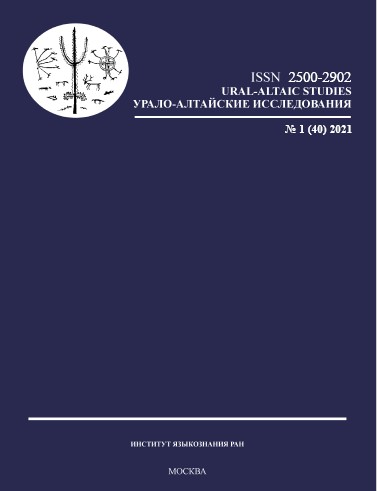О водско-ижорской конвергенции и внутриидиолектном континууме (на примере одной кумулятивной руны)
Votic-Ingrian convergence and intra-idiolectal continuum (a case study of a chain rune)
Author(s): Fedor RozhanskiySubject(s): Phonetics / Phonology, Lexis, Comparative Linguistics, Sociolinguistics, Finno-Ugrian studies, Philology
Published by: Институт языкознания Российской академии наук
Keywords: Votic; Ingrian; language contacts; convergence; borrowings;
Summary/Abstract: This paper analyses different variants of the Votic chain rune Kuza piippu? “Where is the pipe?” in the context of Votic-Ingrian convergent processes. The main focus is made on the alternation between the lexemes “granary” and “fence”, and the structure of postpositional phrases containing these lexemes. The analysis is based on 13 variants of the rune published by several researchers, and three variants of the same rune recorded by the author in the village of Luuditsa of the Kingisepp region. In different variants of Kuza piippu?, three lexemes alternate within the same line: ratiz ‘granary’, aitta ‘granary’, and aita ‘fence’. The paper concludes that the first variant is the original Votic lexeme meaning ‘granary’, the second one is an Ingrian word that was not fully adopted by Votic, and the third variant emerged as a substitution of the unfamiliar Ingrian word with the phonetically closest Votic word. The Ingrian influence is observed also in the postpositional phrase with the discussed lexemes (‘under the granary ~ fence’). In the earlier versions of the rune, one finds the postposition alla ‘under’ as a separate word. In more recent variants, the head noun and postposition are usually written together as one word, with a formative n between them. This n is the Ingrian marker of the genitive case that was later re-analyzed as the initial consonant of the postposition (alla > nalla). The research has revealed that even in the variants recorded from the same speaker, the combination of Votic and Ingrian elements is almost arbitrary. The Votic-Ingrian ratio is not as much a characteristic of the idiolect, but rather a characteristic of a particular text. Therefore, the idiolect cannot be considered as a minimal sociolinguistic object. The author introduces the notion of “variolect” as a language variant with a particular ratio of languages in contact that characterizes a given speech sample. The mixing of Votic and Ingrian in the western Votic villages is a vivid example of iterative convergence. The Lower Luga Ingrian that emerged as a convergent variety on the basis of several Finnic languages (Ingrian and Votic, most of all), gives birth to new contact varie ties when acquired by Votic speakers.
Journal: Урало-алтайские исследования
- Issue Year: 2021
- Issue No: 01 (40)
- Page Range: 61-76
- Page Count: 16
- Language: Russian

